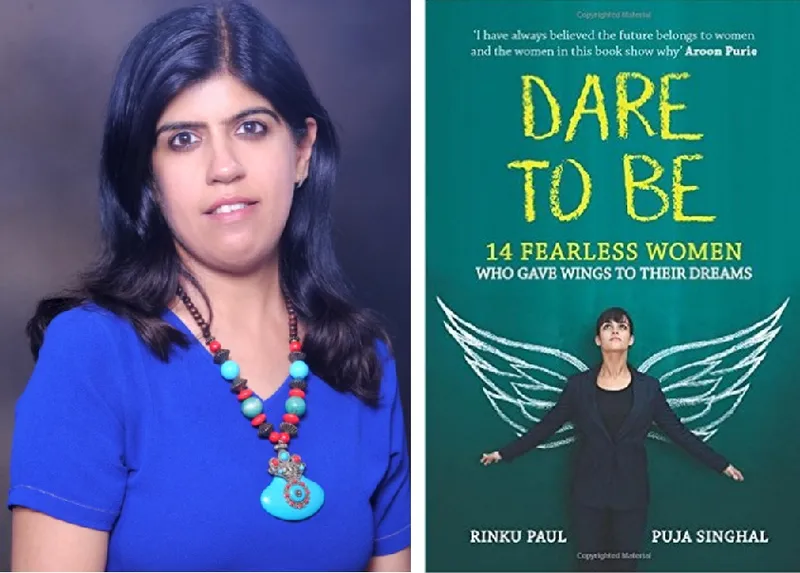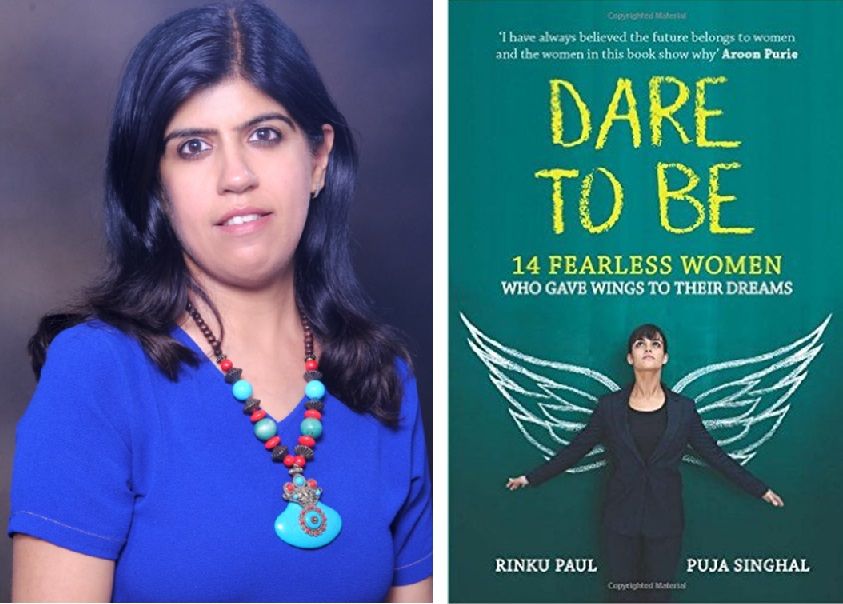‘Women entrepreneurship in India has hit a tipping point’ - Rinku Paul, author, ‘Dare to be’
Rinku Paul spent 16 years with the news channel Aaj Tak, a part of the India Today Group, and is now a life coach, corporate trainer and neurolinguistic programming practitioner. She co-founded writing studio The Muse along with HR specialist Puja Singhal. Rinku and Puja co-authored the book Dare to Be: 14 Fearless Women Who Gave Wings to Their Dreams (see my book review).

Rinku joins us in this interview centred on the startup movement in India, women entrepreneurship and storytelling techniques.
YS: How did you get the idea for writing this book? How did you divide the work between two co-authors?
RP: When we started our own entrepreneurial sojourn after working in the corporate sector for nearly two decades, we did not know that our journeys would lead us to chronicle those of many others. Perhaps the seeds of the book were sown there. What we realised were the many issues that one has to face as one ventures out to take an untrodden path.
There are, of course, your own fears to contend with, the naysayers you need to out shout and, as a woman entrepreneur, a patriarchal society to contend with. In an ecosystem where generations have grown up ruing the lack of female role models, we felt that inspiring stories in the domain were the need of the hour. Essentially, we wanted to infuse the women’s entrepreneurial and creative ecosystem with meaningful storytelling.
These tales are even more precious in the light of the fact that India ranks a low 70 out of 77 countries covered in the 2015 female entrepreneurship index brought out by the Washington-based Global Entrepreneurship and Development Institute.
One division of work, of course, was the interview process itself. Other than that, since we wanted each story to be a true and telling reflection of the life, struggles and achievements of the person featured, we decided to become editors of each other’s copies. So if one of us wrote the first draft, the other took to ruthless editing. Each story went through a couple of iterations until we were completely sure that it was as close to conveying what the person being featured had intended.
YS: Are there plans to add an online companion with resources, videos, etc.?
RP: Yes, definitely. More than just a book, Dare to be is meant to be a movement, and also a community that can reach out to partake of each other’s experiences. With the growing reach of digital media, we are looking at putting together a robust online go-to companion that showcases many such compelling stories both by way of videos and the written word.
YS: How did you choose the 14 women you interviewed for the book, as compared to the large number of potential candidates out there?
RP: The primary filter, of course, was that we wanted to highlight stories of women who had chosen to give up highly successful corporate careers to pursue a passion and had been successful the second time around as well. What was equally, if not even more important than their success, was the fact they hadn’t been cowed down in the face of overwhelming odds. The 14 women that we featured in the book are poster women when it comes to both these aspects.
Another aspect that led us to these 14 women was that we wanted to cover women across the professional spectrum, who had different career paths but were united by a common theme of their passion. The women featured in the book, therefore, range from being performers to founders of multi-million dollar businesses, as well as social entrepreneurs.
If in Neeti Palta’s story, one gapes in awe at the determination that led her to quit a high-flying advertising job to venture into the male-dominated world of stand-up comedy, in Kanika Tekriwal’s story is evident the single-minded pursuit of her passion that refused to be stemmed even by a dreaded disease. Sairee Chahal and the Sheroes story is a deep affirmation of the fact that when you have a voice, you need to start giving back to society.
Malini Agarwal’s story, on the other hand, proves the axiom that you can make anything your job as long as it is your dream and passion driving it. Should any of these stories inspire someone to dust themselves off after a fall and keep going, we would have achieved what we set out to do.
YS: What is your next book going to be about?
RP: As of now, we are continuing to work towards instilling the women entrepreneurial ecosystem with inspiring and meaningful stories. Our next book explores a unique theme within the broad niche of women who have managed to make a mark in the world of business, without fear or favour. The book has been commissioned by Penguin Random House.
YS: How was your book received? What were some of the unusual responses and reactions you got?
RP: The response to the book has been overwhelming, to say the least. We have had so many women walk up to us to tell us that they found the book inspiring and that they could identify with the issues raised in the book. The most cherished response to the book perhaps came from Ms. Anu Aga, who so graciously agreed to release the book, as she found it “heartening” with “its refreshing stories of women entrepreneurs who defy tradition.”
YS: What are the typical challenges entrepreneurs face as they scale up their company from the initial phases to become a mature organisation?
RP: Scaling up is undoubtedly when you are truly tested as a leader. Moving from startup mode to a mature business organisation requires moving away from the hands-on style of working that defines most startups, to thinking at a more strategic level and envisioning the future of the company beyond you. This ability to delegate and disassociate oneself from day to day operations is difficult for entrepreneurs, especially as they have built a product or service from scratch. You need to personally transform yourself from a business creator to a people-manager and leader.
Another big challenge is to do with dilution of company culture. As the organisation grows from a 20-member team to one that is 50 then 100 or even 500 strong, there is a loss of cultural identity. From treating each other as part of one’s family and sharing the same vision, you suddenly know only a handful of people and are not sure which direction the company is headed and who is making what decisions. It is important to establish a common cultural identity and business purpose, and lay down robust processes before you make the big leap.
Talent shortage is, of course, a very real problem to deal with, and having the right people in place is important to ensure you don’t burn yourself in the process of scaling up.
YS: How should innovators strike that delicate balance between 'Stick to your vision' and ‘Adapt to a changed world'?
RP: Technology has accelerated the pace of change, and what applies today might become irrelevant less than five years from now- that is how fast the world is changing. What entrepreneurs need to do in such a changing environment is to have a clear differentiator or core purpose for their existence. As long as you are aware of your core value proposition, it is possible to keep innovating and adapting around it to suit changing consumer trends. The need to pivot based on market conditions is a reality that innovators must be open to.
YS: Is there such a thing as the 'ideal age' for an entrepreneur, or can the startup bug bite you at any time?
RP: Age is just a number; all you need is a great idea, passion and a deep gut to continue pushing for success, undeterred by failures and setbacks. There are enough and more examples of college dropouts turned entrepreneurs, but as our book highlights through some examples (and our next one will highlight it even further), there are enough and more late bloomers too- people who turn entrepreneurs late in life and show a remarkable aptitude for innovating and adapting as business leaders.
YS: Who are some of the entrepreneurs you admire the most today? What is it that makes them role models?
RP: It’s awfully hard to name one or even a few. There are so many startups that are doing some awesome work, whether it is in the commercial space or in the space of social entrepreneurship. Essentially, startups that are solving real problems and are not focused on exits alone, would get my vote. Many of the women from the stories featured in the book became our role models for the way they lived out their passion.
YS: What emerging trends do you see in terms of women empowerment in the workforce, and women entrepreneurship?
RP: The most heartening trend of course is that women entrepreneurship has hit a tipping point. In the course of writing the book, of course, we saw how women are ready to trade off their steady paychecks to follow their passion for entrepreneurship. While patriarchal mindsets and unequal pay for similar work are still a reality, the good news is that the business environment is slowly but surely changing. Most important, perhaps, is the fact that women are no longer ready to be cowed down by virtue of their gender.
YS: Where is India situated today in the entrepreneurship movement? What can be done by industry, government and society to further promote entrepreneurship?
RP: There certainly is a big change in the Indian entrepreneurial ecosystem. Organised attempts at removing regulatory road blocks, the increased availability of funds and education leading to removal of the mind-blocks related to entrepreneurship are fuelling the movement. Of course, we still have a long way to go. If one had to name one aspect that could further the scope of entrepreneurship, it would be to introduce quality entrepreneurial training in the higher education system. That would bring about some method in the madness and also suitably prepare aspiring entrepreneurs.
YS: What are the key elements of storytelling that entrepreneurs can use in their narrative, pitches and PR?
RP: Nothing facilitates connection like storytelling; so yes, it is a great enabler for entrepreneurs. We are hardwired to learn and retain better if what someone has to say makes an emotional connect. That surely makes a strong case for storytelling as against using ream after ream of statistics alone.
Some of the elements of storytelling that entrepreneurs can effectively use include keeping their story 1) Simple – The thumb rule clearly is that simplicity aids memorability, 2) Real- Stories that make the maximum impact are ones that speak of a first-hand account, and 3) Honest- Remember to keep the stories truthful and honest, because if you do that, it is bound to make an emotional connect with the audience.
In addition, a good leader doesn’t just tell engaging stories, he is also conditioned to listen to stories and also trigger stories. As entrepreneurs therefore, storytelling is a great way to both engage as well as influence.
YS: What kinds of teaching and coaching activities are you engaged in, to reinforce the messages of the book?
RP: As a Life Coach, among other things, I also work with a number of people, facilitating their entrepreneurial journeys. As for disseminating the message of the book specifically, I have been a part of entrepreneurship forums post the release of the book, speaking around the whole aspect of women entrepreneurship.
YS: What is your parting message to the startups and aspiring entrepreneurs in our audience?
RP: My message clearly is to “Dare to Be”. To borrow two lines from the book, remember that “rejection means nothing more than someone not being able to see what you see” and that “it is better to live with ‘Oh Shit’, rather than ‘What if’.”
Having said that, Dare to Be is not an irresponsible call to dump your corporate careers, it is an impassioned appeal to be true to yourself and let that guide your life and career path.









![[Funding alert] Electric vehicle startup Simple Energy in talks to raise $1M](https://images.yourstory.com/cs/2/11718bd02d6d11e9aa979329348d4c3e/Imagehrn6-1595836341886.jpg)

